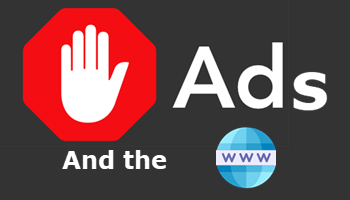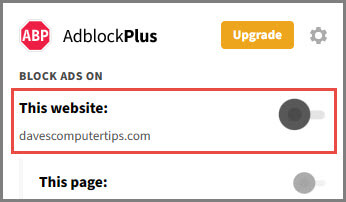Something terrible happened to the World Wide Web when advertising agencies realized that the World Wide Web’s massive reach made it the perfect platform for advertising and we were all subsequently bombarded with ads of all descriptions at every turn. It was only logical then that someone, a lot cleverer than I, would eventually come up with software specifically to block this advertising assault.
However, while the advent of ad-blockers undoubtedly provided welcome relief for millions of users, the subsequent proliferation of ad-blockers has caused grief for many owners of smaller websites as well as inexorably changing the face of the World Wide Web forever. Many of the smaller independently owned websites we once cherished are now gone with wealthy and powerful media conglomerates now dominating the World Wide Web.
Independently Owned Websites a Dying Breed
Most smaller independently-owned websites, including Daves Computer Tips, rely solely on ad revenue as their only source of income and ad-blockers have decimated that income to the point where many site owners end up with several somewhat distasteful options- they can either shut up shop, sacrifice their ethics for the sake of survival, or be gobbled up by one of the larger media organizations.
One only has to consider the demise of the once very popular TechSupportAlert (Gizmo’s Freeware) website to know that the writing for many independently owned websites was on the wall.
Daves Computer Tips has been approached in the past by organizations with offers of affiliations but following some research by yours truly has revealed, shall we say, those companies’ less than stellar reputations, we have politely declined. That said, I cannot blame those site owners who, when faced with the unenviable choice between either sacrificing their reputation or extinction, will opt for the former.
Many of the well-known tech sites that some of you visit on a regular basis, perhaps under the impression that they are independently owned, are actually just part of a much larger organization. Here are but a few examples:
- TechCrunch: is owned by Apollo Global Management, along with AOL and Yahoo
- Gizmodo and Lifehacker: are both owned by the Fusion Media Group
- Ghacks: was acquired by Softonic in 2019 (Softonic also owns the FileHippo download portal)
- CNET and ZDNet: are owned by the US-based Red Ventures media company
- MakeUseOf: is owned by the Valnet Inc. media company
And the list goes on. The worrying aspect of all this is that most, if not all, of these parent companies are described as providing “marketing” and “advertising” services. Call me a cynic, but the business models of these parent companies do not exactly inspire trust. When income and profit take precedence, one has to wonder at what point factual reporting gives way to quid pro quo arrangements.
What You Can Do To Help
I absolutely loathe that the World Wide Web has lost, and continues to lose, independently owned websites to the benefit of these large and wealthy media organizations who, if the trend continues, will eventually dominate the World Wide Web even more than they do today. If you’re of the same mind, what you can do to help maintain a free and open WWW is whitelist those sites in your ad blocker that you tend to visit and enjoy on a regular basis. And that goes for Daves Computer Tips as well.
Keep the World Wide Web free and open by utilizing the whitelist option in your ad blockers. One simple little click can help keep those smaller, independent websites alive and well.
NOTE: It’s important to note that you do not need to click on any ads for the website to earn revenue, merely allowing the ads to display will help no end.
—



Glad you pointed this out. Most people, myself included, detest ads. Especially the damned pop-ups. I was an early adopter of ad-blockers and privacy apps and other means. I find it strange that advertisers, who are certainly aware of the hostility towards them, have still not learned how to present them in a less aggressive manner. Rather, they created anti-ad blockers. It seems an endless conflict. Yet, I do have sympathy with independent websites that need the revenue to continue.
My set-up allows me virtually ad-free access to almost all websites I use, a set-up and forget it basically. You have reminded, because I had forgotten, that sometimes I need to pause and question when I’m on independent websites, should I whitelist this? Thanks for the reminder.
I believe in the beginning the ad producers were trying too hard to place ads. As in real estate, location is everything, well almost. I started using ad blockers because:
1. Ads were unrelated to anything I was interested in.
2. They were placed at the beginning or the middle intrusively where I was trying to read.
3. Some ads prevented the site from operating properly, ie., taaking over the page or refusing to let you leave the page.
4. There was no way in the beginning to whitelist sites or ads.
5. I remember one page I was visiting that had 14 ads in the first frame with two line of story text, a little overkill.
6. Some ads that I have tried to click on do bring me to the proper page and I will look at the product. Then when i need to return to the previous page, it wants to show me more and similar ads.
7. I now do whitelist some 20-25 sites where I don’t mind seeing the ads and they are very specific sites that I do feel comfortable with their ads, not only for my interest but support the web site I like.
If in the beginning the advertisers and their placement agencies had been more judicious in placing their ads, they would not be dealing with ad-blockers.
I agree wholeheartedly with every point you’ve made Vincent. However, when site owners first realized that ad-blockers were causing a significant decrease in revenue they started to compensate by including even more ads.
That is/was the wrong approach, in my opinion. That said, I can’t really blame them.
Jim, I agree. But for the fans who are less tech-able, can you do a short article on how to allow ads on certain sites. I know its simple when you know, but not when you don’t. thanks
Sure, no problem Clas. I’ll get that one out soon.
My blocker is off now for DCT.
Good on you, thanks Frank.
This article is a much needed reminder for those using Adblockers, like me. I have disabled any adblocking on DCT, and other small sites, for years. But sometimes I do forget to do so.
However, the constant bombardment with animated ads and – even worse – video ads with sound that were playing unasked, were driving me to a point where I’m considering it a measure of self-defence to use an adbocker. The internet-ad industry has lost my trust with intrusive ads many years ago and I’m not even willing to give them a 2nd chance at this point.
“a measure of self-defence”
Could not agree more. As I mentioned in an earlier comment, when site owners realized that ad-blockers were the cause of a serious decline in revenue, many sites resorted to even more ads, and even more invasive ads. Completely the wrong approach, in my opinion.
Up until last year I did not mind adds on sites I visited and did not even try to block them. Then the advertisers got greedy. It wasn’t enough that their irrelevant adds appeared on the side of each page, they started pushing them in the middle of articles I was interested in reading. Sometimes they would pop in and out causing the article to jump around the page. Then there are the ridiculous adds that are just CRAP or cons. They try to make themselves appear to be something they are not or try to fool you that they are part of the article you are reading. It is extremely rare I will click on and add on a website. If I am really interested, I will do an Internet search for the product.
For the most part I still tolerate adds on sites I enjoy, but now all browsers have these page reader options. When I get tired of all the useless CRAP breaking up the article I want to read, I will switch to a “page” mode to read the article and then switch back.
I hope this is not removing revenue from Dave’s Computer Tips.
“Then the advertisers got greedy. It wasn’t enough that their irrelevant adds appeared on the side of each page, they started pushing them in the middle of articles”
This wasn’t down the the advertisers Tom. Again, this was largely down to the site owners trying to compensate for the loss of revenue due to ad-blockers. Not the right approach, but I can’t say as I blame them.
I only go to websites I trust. But their advertisers? Can I trust them too? Will DCT (and others) accept liability if I’m fed an ad that contains malware?
Hey Scott,
That’s a good point. For example, I know of trusted sites that display ads for malicious software as part of an affiliation. We (DCT) have no such affiliations and I can assure you, you are perfectly safe when visiting DCT.
Bear in mind too, that malicious ads can only deliver their payload if/when the user clicks on them. Rule of thumb- if in any doubt, don’t click the ad.
I use Firefox. I have Daves Computer Tips on my browser screen page right now. I do not see any options to click on to add this site to whitelist sites or to unblock it. If I go to extensions I have one Ad Blocker but when I click on Manage or Options I do not see any option to add Daves Computer Tips to a whitelist or to put it on a do not block list. Can anyone explain how to do this??
What is the name of your ad-blocker extension in Firefox?
I am using U Block Origin. I went into it again in their OPTIONS tab and see I missed the tab at top for “My Filters” which seems to be the answer to my problem. I looked also in Win10 and found “Internet Options”. There I was able to copy DCT address link and past it into the Security / Trusted Sites box. Seems to work ok. Hopefully it will not block while on DCT now.
Love your articles and tips. I always look at all the articles in every DCT email as there are always some things I read on further. Keep up good work.
Hi GPTDesign,
uBlock Origin places an icon to the right of the address bar in your browser. All you have to do is click on it to enable/disable whitelisting the site you are visiting.
Thank you for your support,
Richard
that’s the answer i was needing…thanks richard
There’s actually a little bit more to it than that. Clicking uBlock Origin’s icon in the address bar opens up its menu. From there, left-click the blue power icon at the top of the menu to whitelist the entire website, CTRL + left-click to whitelist the current page only.
Sorry I jumped in, Jim. I thought you were busy.
@Richard,
That’s okay mate. Not busy, quite the opposite, in bed asleep. 🙂
I’ve always wondered how Jim does that. Typing while asleep, I mean… man, he’s good 😉